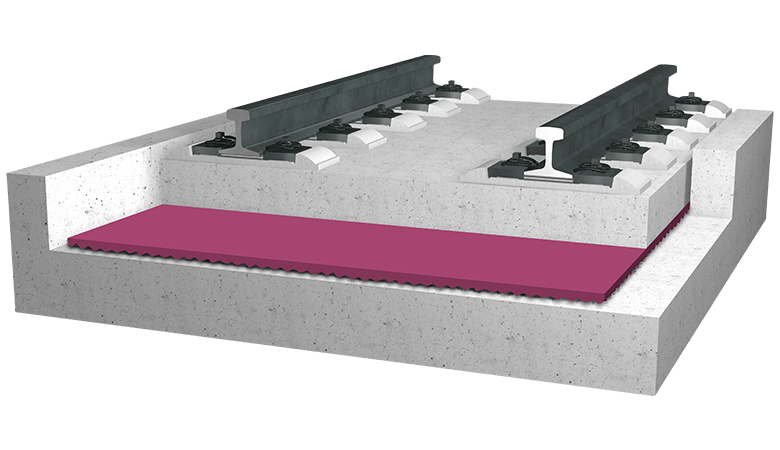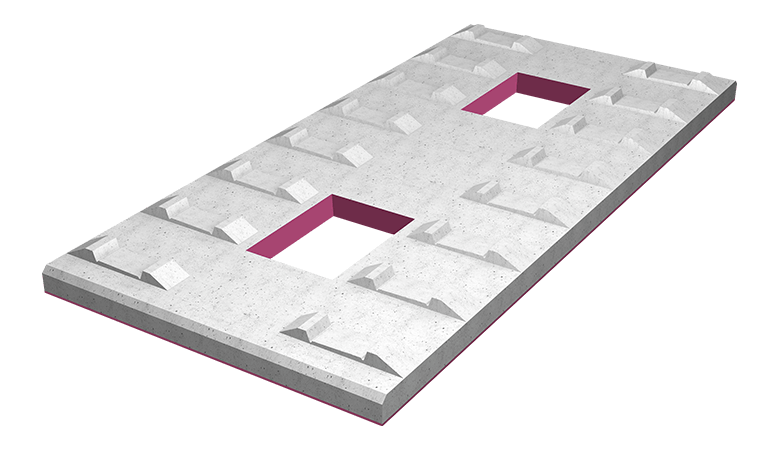DAMTEC® SBM K – Under ballast mats for railway applications
DAMTEC® under ballast mats are products for decoupling and protection under rail systems, tested according to DIN 45673-5 (Mechanical vibrations – resilient elements used in railway tracks – laboratory test procedures for under ballast mats (UBM)). They reduce structure-borne noise and secondary airborne sound as well as vibration emissions. In the case of ballasted track, the service life is extended by a lower and more uniform load. At the same time, they also protect engineering structures and waterproofing. DAMTEC® SBM K sub ballast mat are supplied in rolls. SBM stands for the term “Sub Ballast Mat”, K for the material “rubber” (German: Kautschuk).
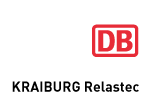
Our under ballast mats comply with the technical delivery conditions of Deutsche Bahn (DBTL 918071. The user releasing as a controlled design of the under ballast mat DAMTEC® SBM K 10V for ballasted track was approved by DB Netz AG from superstructure technical point of view under the TM‐titel 4‐2015‐10511 I.NPF 1 to Ril 804,820,824.
In addition to exact measurements of the static bedding modulus (Cstat1, Cstat2), the dynamic bedding modulus (Cdyn1, Cdyn2) and the mechanical fatigue strength, DAMTEC® Under Ballast Mats of the SBM K series are also tested for numerous other technical values such as water and freeze/taw resistance.
Typical examples of use:
- Structure-borne noise isolation on track systems in urban centres, especially in the immediate vicinity of buildings
- Reducing the noise and vibration emission to buildings with particularly high requirements for noise prevention (for example, opera houses, concert halls, test institutions, hospitals)
- Protecting against low-frequency vibrations caused by space-limiting surfaces (secondary airborne sound)
- Stabilising track constructions; particularly in high-traffic routes
Extract from the product portfolio for DAMTEC® SBM K Under Ballast Mats
Flat products:
- DAMTEC® SBM K 10 • K 10 V
- DAMTEC® SBM K 20 • K 20 V
- DAMTEC® SBM K 23 • K 23 V
Profiled Products:
- DAMTEC® SBM K 17/8 • K 17/8 V
- DAMTEC® SBM K 25/7 • K 25/7 V
V = version with laminated geotextile
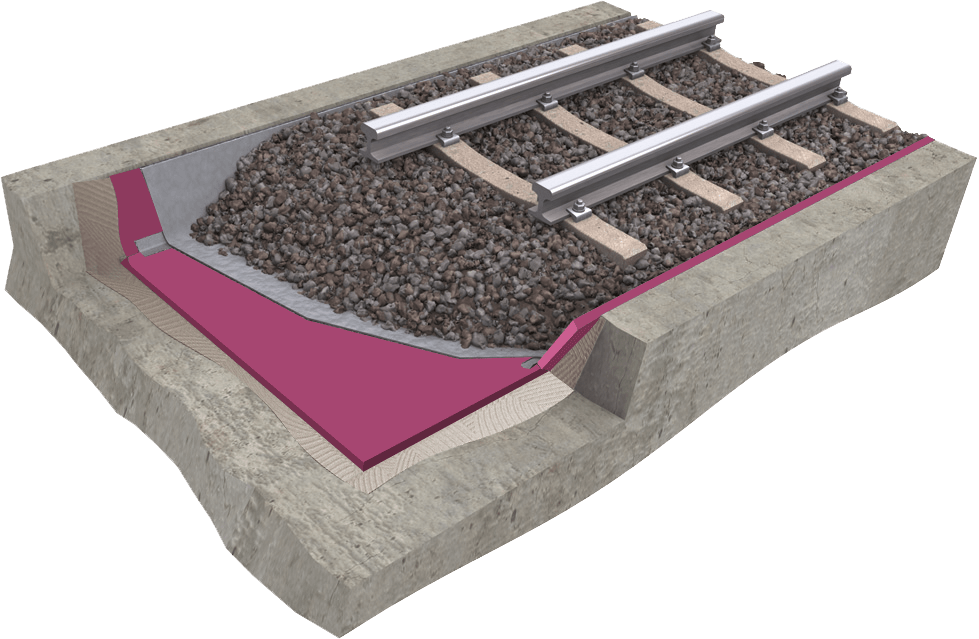
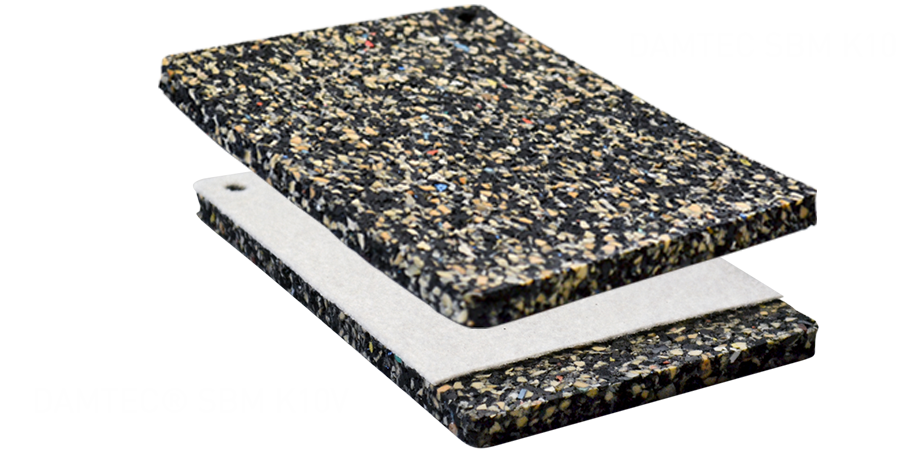
Application areas according to DBS 918071
| Thickness | Cstat1 [N/mm³] |
|---|---|
| 10 mm | 0.12 (+/- 0.02) |
| Axle load < 25 to / v > 200 km/h | |
| 20 mm | 0.06 (+/- 15%) |
| Axle load < 25 to / 120 km/h < v < 200 km/h | |
| 40 mm | 0.03 (+/- 15%) |
| Axle load < 25 to / v < 120 km/h | |
| 60 mm | 0.02 (+/- 15%) |
| Axle load < 16 to / v < 120 km/h | |
Static bedding modulus measured in accordance to DIN 45673-5
Advantages and properties
of DAMTEC® SBM K Under Ballast Mats
protect the sensitive waterproofing layer against damage by the ballast
extend the life of the ballast
protect adjacent structures by reducing vibrations
environment-friendly
extremely economical
easy installation
low water absorption
extremely durable
reduce the transmission of structure-borne sound
reduce secondary airborne sound
keep track position stable for longer period of time
FAQs regarding DAMTEC® Under Ballast Mats
What material are DAMTEC® Under Ballast Mats made of?
DAMTEC® under ballast mats consist of a special mixture of PU foam and high-quality recycled virgin rubber granules with a PU elastomer bonding agent i. e. from unused new raw materials. This leads to the desired properties and takes environmental protection into account. An aging of the rubber granulate is thus excluded. In particular, used tyres are not used here. With the extensively tested formulations, the products meet special requirements resulting from the loads in the track area. These elastomer materials are also used in other demanding areas such as building construction, civil engineering and tunnelling. Particularly noteworthy is the long-term behaviour, which guarantees a constant high level of effectiveness over decades. In this way, they efficiently counteract the multi frequency vibrations and shocks that are transmitted to the environment.
What does DAMTEC® SBM K stand for?
The term is an abbreviation of the following words::
Sub
Ballast
Mat
Kautschuk (rubber)
In which form is DAMTEC® SBM K delivered?
The Under Ballast Mat is supplied as standard in 1,250 mm widths as rolled goods. Depending on the thickness, different roll lengths are available. Plates or other lengths can also be produced for certain project requirements.
How are DAMTEC® Under Ballast Mats installed?
You can find detailed installation instructions in our download area. When used in the DB AG area, the guidelines for ballast work, “Install Sub Ballast Matting” (824.1510), must be observed.
How many years has DAMTEC® Sub Ballast Mat been on the market?
We realized our first reference project “Viadukt Sembrancher” in Switzerland as early as 1997, so we can look back on more than 20 years of experience in the railway sector. To date, we have successfully supplied numerous major projects such as the Wiener Linien, the tram in Graz, the Butler Extension in Perth (Australia) or the metro in Kuala Lumpur (Malaysia) with Sub Ballast Matting.
How does the DAMTEC® Team support me in my railway project?
Solution Development & Detailed Solutions
Our many years of experience and our know-how with products for acoustic and vibration reduction are a guarantee for the solution of even very complex problems. Together with you, our specialists will develop effective systems to eliminate or minimize disruptive factors in the problem areas. In addition to standard solutions based on experience, we are of course also technically and personally in the position to implement completely new solutions, exactly adapted to your requirements.
Calculations, simulations and efficacy forecasts
To find out how effective measures can be in dealing with an emission problem, you don‘t have to wait until they are implemented. After a first inspection and analysis of the conditions on site, our specialists are able to create a calculation model in which all relevant factors regarding vibration and damping behaviour with different material properties are taken into account. This results in a realistic simulation that allows fine-tuning of these factors and enables our specialists to develop the optimum solution. At the end of the planning phase, you will receive proof of the expected effectiveness of the system. This efficacy forecast gives you the assurance in advance that your expectations will be met successfully.
Our services at a glance
- material testing and measurement on our own large scale test bench
- project support from the beginning
- installation advice and site support
- preparation of installation plans
- vibration-technical, mech. measurements
- solution development
- calculation and simulation
- efficacy forecasts
Technical terms - simply explained!
Static bedding modulus
With bedding theory, the track is imagined as an infinitely long rod that is laid on a continuous, elastic base. The bedding modulus is the elasticity value of the whole system, rail – railroad tie – ballast – substructure – substrate, and is used to estimate the static deflection of the operating load. This quantity is a measure of the stiffness that must be determined experimentally. The static bedding modulus basically indicates how deep the rail sinks under slow traffic conditions or a stationary train.
The bedding modulus is the ratio of the stress to the deflection. Usually, the secant modulus is measured, for example, between 0.02 N/mm² and 0.10 N/mm² . Alternatively, the tangent modulus can be determined.
Deflection
A distinction must be made between the deflection and subsidence of the elastomer and the rail deflection. The deflection can be determined using the spring characteristics and is the distance in millimetres by which the material is compressed under a certain tension.
The rail deflection when in use takes into consideration the stiffness in the track superstructure from the vehicle to the substrate. It is calculated statically for the stationary and dynamically for the moving train. Depending on speed, axle load, superstructure type, sub-type and DAMTEC® type, the deflection is usually between 1 mm and 3 mm.
Dynamic bedding modulus
A distinction must be made between the low-frequency (superstructure dynamics) and the high-frequency dynamic bedding modulus (damping of structure-borne noise). With the first-mentioned characteristic value, the bending deformation of the rail under the rolling wheel can be estimated from the interaction of bending elasticity of rails and railroad ties, including ballast.
The higher-frequency dynamic bedding modulus of a ballast mat influences the natural frequency of the elastically mounted superstructure as a vibratory system as a whole and thus the insertion loss. The test is performed with a static preload.

Insertion loss
The insertion loss ΔLe (in dB) is a characteristic value that expresses the extent to which inserted measures contribute to reducing the structure-borne noise introduced into a system. The insertion loss ΔLe is the ratio of the structure-borne sound power “without installed measures” to “with installed measures”. It is a characteristic value of the entire system – from the vehicle to the substructure.
Forecast calculations
Since the mechanisms for the generation and propagation of structure-borne sound associated with rail transport are widely known, the expected effect of mitigation measures can be calculated in advance after a thorough evaluation of the system in the way they are to be used. There are many tried and tested calculation models available for this purpose. The combination of advanced materials that meet all modern requirements for effective sound and vibration protection, as well as the vast experience in implementing more effective measures make DAMTEC® the ideal partner for sound and vibration reduction in the railway sector.
New standard for Under Ballast Mats
In future, DIN 45673-5 will be replaced by EN 17282. Structural elements that are placed between the substructure and Under Ballast Mat (UBM) must prove their performance according to this new standard. Preliminary and routine tests as well as additional data are defined here. DAMTEC® will meet all these new requirements. For further information please contact us at any time.
Installation of Under Ballast Mat DAMTEC® SBM K 10V
Sie sehen gerade einen Platzhalterinhalt von Standard. Um auf den eigentlichen Inhalt zuzugreifen, klicken Sie auf den Button unten. Bitte beachten Sie, dass dabei Daten an Drittanbieter weitergegeben werden.

